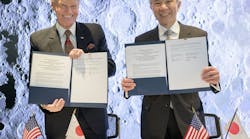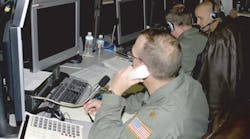By J.R. Wilson
MOUNTAIN VIEW, Calif. — Researchers as NASA Ames Research Center in Mountain View, Calif., have a breakthrough biological method to make ultrasmall structures that could lead to a 99 percent reduction in the size of electronic components.
According to the November announcement, the scientists are using modified proteins from "extremophile" microbes that live in near-boiling, acidic hot springs to grow mesh-like structures only visible with an electron microscope.
"Our innovation takes advantage of the innate ability of proteins to form into ordered structures and for us to use genetic engineering to change nature's plans, transforming these structures into something useful," says Jonathan Trent, principal investigator of a research project to produce so-called "nano-electronics."
"We took a gene from a single-celled organism — sulfolobus shibatae, which lives in near-boiling acid mud —and changed the gene to add instructions that describe how to make a protein that sticks to gold or semiconductors," adds co-investigator Andrew McMillan, primary author of a paper on the research. "What is novel in our work is that we designed this protein so that when it self-assembles into a two-dimensional lattice or template, it also is able to capture metal and semiconductor particles at specific locations on the template surface."
Scientists added the modified gene segment to a harmless form of rapidly multiplying E. coli bacteria to produce vast quantities of the new protein. Using such a robust protein, which is more stable in heat than the proteins E. coli naturally makes, enables scientists to purify the genetically engineered protein easily by heating the broth containing the bacteria to destroy unwanted natural E. coli proteins.
The engineered protein, which starts out just a few nanometers wide, remains intact and self-assembles into an organized lattice or template. These tiny, flat crystalline structures, made of rings about 20 nanometers across, are about 5,000 times smaller than the width of a human hair (a nanometer is one billionth of a meter).
Trent says the ultimate goal of the research is to prove proteins can be used to build devices that will be of value to NASA in the search for extraterrestrial life. They also could be used in biomedical applications here on Earth.


